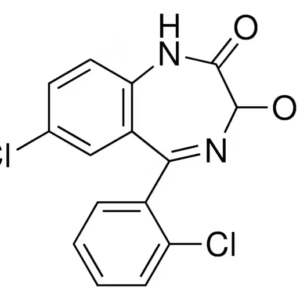Diazepam, sold under the brand name Valium among others, is a medication from the benzodiazepine family. It acts as an anxiolytic, meaning it helps reduce anxiety. Diazepam is used to treat a variety of conditions, including anxiety disorders, seizures, alcohol withdrawal syndrome, muscle spasms, insomnia, and restless legs syndrome.
It may also be administered to cause short-term memory loss during certain medical procedures. The drug can be taken orally, rectally (as a suppository), intramuscularly, intravenously, or as a nasal spray. When injected into a vein, its effects begin within 1 to 5 minutes and last up to an hour. When taken by mouth, effects typically begin within 15 to 60 minutes.
Common side effects include drowsiness and poor coordination. Serious side effects are rare but can include breathing difficulties, suicidal thoughts, and—in people with epilepsy—an increased risk of seizures if used too often. In some cases, paradoxical reactions like agitation or excitement may occur.
Long-term use can lead to tolerance, physical dependence, and withdrawal symptoms if the dose is suddenly reduced or stopped. Abrupt discontinuation after prolonged use can be dangerous. Even after stopping, some cognitive impairments may persist for six months or longer.
Diazepam is not recommended during pregnancy or breastfeeding. It works by enhancing the effect of gamma-aminobutyric acid (GABA), a neurotransmitter that slows brain activity and helps induce calmness.
Diazepam was first patented in 1959 by Hoffmann-La Roche and became commercially available in 1963. It quickly rose to prominence as one of the most widely prescribed medications globally. In the United States, it was the best-selling drug from 1968 to 1982, with over 2 billion tablets sold in 1978 alone.
Although its patent expired in 1985, diazepam continues to be widely used. As of 2022, it ranked as the 169th most prescribed medication in the U.S., with more than 3 million prescriptions that year. Today, over 500 brands of diazepam are available worldwide. It is also included on the World Health Organization’s List of Essential Medicines, highlighting its global importance in healthcare.
From a chemical standpoint, diazepam is a classic 1,4-benzodiazepine. It does not contain any chiral centers but exists in two conformers—designated as the ‘P’- and ‘M’-conformers. Studies using circular dichroism (CD) spectra have shown that the ‘P’-conformer has a higher binding affinity for α1-acid glycoproteins in serum.
Medical uses
Diazepam is primarily used to treat a variety of conditions related to the nervous system. Its main applications include the treatment of anxiety, insomnia, panic attacks, and symptoms associated with acute alcohol withdrawal. It is also commonly administered as a premedication to induce sedation, reduce anxiety (anxiolysis), or cause amnesia before certain medical procedures, such as endoscopy.
In 2020, diazepam was approved in the United States as a nasal spray for interrupting seizure activity in individuals with epilepsy. Among benzodiazepines, diazepam is often the preferred drug for tapering off benzodiazepine dependence, thanks to its long half-life. This pharmacokinetic property allows for a more gradual and controlled dose reduction. Notably, benzodiazepines like diazepam generally have low toxicity in cases of overdose.
Common Clinical Uses of Diazepam Include:
Treatment of anxiety, panic attacks, and agitation
Management of neurovegetative symptoms related to vertigo
Relief from alcohol, opiate, and benzodiazepine withdrawal symptoms
Short-term use in insomnia treatment
Treatment of muscle spasms and as part of the care for tetanus, along with intensive therapy
Adjunctive therapy in spastic muscular paresis (e.g., paraplegia or tetraplegia) caused by stroke, multiple sclerosis, or spinal cord injuries, typically as part of a broader rehabilitative program
Palliative care in stiff person syndrome
Sedation, anxiolysis, or amnesia before or after surgical or endoscopic procedures
Management of complications arising from stimulant overdoses or psychosis, such as those induced by cocaine or methamphetamine
Emergency treatment of organophosphate poisoning, helping to reduce the risk of brain and heart damage from seizures
Prevention of oxygen toxicity during hyperbaric oxygen therapy
Seizures
Intravenous diazepam or lorazepam are first-line treatments for status epilepticus.[19][40] However, intravenous lorazepam has advantages over intravenous diazepam, including a higher rate of terminating seizures and a more prolonged anticonvulsant effect. Diazepam gel was better than placebo gel in reducing the risk of non-cessation of seizures
The anticonvulsant effects of diazepam can help in the treatment of seizures due to a drug overdose or chemical toxicity as a result of exposure to sarin, VX, or soman (or other organophosphate poisons), lindane, chloroquine, physostigmine, or pyrethroids.[28][43]Availability
Diazepam is marketed in over 500 brands throughout the world. we supplier for medical research p It is supplied in Powder form
The United States military employs a specialized diazepam preparation known as Convulsive Antidote, Nerve Agent (CANA), which contains diazepam. One CANA kit is typically issued to service members, along with three Mark I NAAK kits, when operating in circumstances where chemical weapons in the form of nerve agents are considered a potential hazard. Both of these kits deliver drugs using autoinjectors. They are intended for use in “buddy aid” or “self-aid” administration of the drugs in the field before decontamination and delivery of the patient to definitive medical care.
Contraindications
Use of diazepam is avoided, when possible, in individuals with:[56]
Ataxia
Severe hypoventilation
Acute narrow-angle glaucoma
Severe hepatic deficiencies (hepatitis and liver cirrhosis decrease elimination by a factor of two)
Severe renal deficiencies (for example, patients on dialysis)
Liver disorders
Severe sleep apnea
Severe depression, particularly when accompanied by suicidal tendencies
Psychosis
Pregnancy or breast feeding
Caution required in elderly or debilitated patients
Coma or shock
Abrupt discontinuation of therapy
Acute intoxication with alcohol, narcotics, or other psychoactive substances (with the exception of hallucinogens or some stimulants, where it is occasionally used as a treatment for overdose)
History of alcohol or drug dependence
Myasthenia gravis, an autoimmune disorder causing marked fatiguability
Hypersensitivity or allergy to any drug in the benzodiazepine class
Abuse and special populations
Benzodiazepine abuse and misuse is guarded against when prescribed to those with alcohol or drug dependencies or who have psychiatric disorders.[58]
Pediatric patients
For less than 18 years of age, this treatment is usually not indicated, except for treatment of epilepsy, and pre-or postoperative treatment. The smallest possible effective dose is typically used for this group of patients.[59]
Under 6 months of age, safety and effectiveness have not been established; diazepam is not given to those in this age group.[38][59]
Elderly and very ill patients can experience apnea or cardiac arrest. Concomitant use of other central nervous system depressants increases this risk. The smallest possible effective dose is generally used for this group of people.[59][60] The elderly metabolise benzodiazepines much more slowly than younger adults, and are also more sensitive to the effects of benzodiazepines, even at similar blood plasma levels. Doses of diazepam are recommended to be about half of those given to younger people, and treatment is limited to a maximum of two weeks. Long-acting benzodiazepines such as diazepam are not recommended for the elderly.[19] Diazepam can also be dangerous in geriatric patients owing to a significantly increased risk of falls.[61]
Intravenous or intramuscular injections in hypotensive people or those in shock is administered carefully and vital signs are closely monitored.[60]
Benzodiazepines such as diazepam are lipophilic and rapidly penetrate membranes, thus rapidly cross over into the placenta with significant uptake of the drug. Use of benzodiazepines including diazepam in late pregnancy, especially high doses, can result in floppy infant syndrome.[62] Diazepam when taken late in pregnancy, during the third trimester, causes a definite risk of a severe benzodiazepine withdrawal syndrome in the neonate with symptoms including hypotonia, and reluctance to suck, to apnoeic spells, cyanosis, and impaired metabolic responses to cold stress. Floppy infant syndrome and sedation in the newborn may also occur. Symptoms of floppy infant syndrome and the neonatal benzodiazepine withdrawal syndrome have been reported to persist from hours to months after birth.[63]
Adverse effects
Benzodiazepines, such as diazepam, can cause anterograde amnesia, confusion, and sedation. The elderly are more prone to diazepam’s confusion, amnesia, ataxia, hangover symptoms, and falls. Long-term use of benzodiazepines, such as diazepam, induces tolerance, dependency, and withdrawal syndrome.[19] Like other benzodiazepines, diazepam impairs short-term memory and learning new information. Diazepam and other benzodiazepines can produce anterograde amnesia, but not retrograde amnesia, which means information learned before using benzodiazepines is not impaired. Short-term benzodiazepine use does not lead to tolerance, and the elderly are more sensitive to them.[64] Additionally, after stopping benzodiazepines, cognitive problems may last at least six months; it is unclear if these problems last for longer than six months or are permanent. Benzodiazepines may also cause or worsen depression.[19] Infusions or repeated intravenous injections of diazepam when managing seizures, for example, may lead to drug toxicity, including respiratory depression, sedation, and hypotension. Drug tolerance may also develop to infusions of diazepam if it is given for longer than 24 hours.[19] Sedatives and sleeping pills, including diazepam, have been associated with an increased risk of death.[65]
In September 2020, the U.S. Food and Drug Administration (FDA) required the boxed warning be updated for all benzodiazepine medicines to describe the risks of abuse, misuse, addiction, physical dependence, and withdrawal reactions consistently across all the medicines in the class.[66]
Diazepam has a range of side effects common to most benzodiazepines, including:
Suppression of REM sleep and slow wave sleep
Impaired motor function
Dizziness
Reflex tachycardia[67]
Less commonly, paradoxical reactions can occur, including nervousness, irritability, excitement, worsening of seizures, insomnia, muscle cramps, changes in libido, and in some cases, rage and violence. These adverse reactions are more likely to occur in children, the elderly, and individuals with a history of a substance use disorder, such as an alcohol use disorder, or a history of aggressive behavior.[19][68][69][70] In some people, diazepam may increase the propensity toward self-harming behavior and, in extreme cases, may provoke suicidal tendencies or acts.[71] Very rarely dystonia can occur.[72]
Diazepam may impair the ability to drive vehicles or operate machinery. The impairment is worsened by the consumption of alcohol because both act as central nervous system depressants.[38]
During therapy, tolerance to the sedative effects usually develops, but not to the anxiolytic and myorelaxant effects.[73]
Patients with severe attacks of apnea during sleep may experience respiratory depression (hypoventilation), leading to respiratory arrest and death.[74]
Diazepam in doses of 5 mg or more causes significant deterioration in alertness performance combined with increased feelings of sleepiness.[75]
Tolerance and withdrawal
Diazepam, as with other benzodiazepine drugs, can cause tolerance, physical dependence, substance use disorder, and benzodiazepine withdrawal syndrome. Withdrawal from diazepam or other benzodiazepines often leads to withdrawal symptoms similar to those seen during barbiturate or alcohol withdrawal. The higher the dose and the longer the drug is taken, the greater the risk of experiencing unpleasant withdrawal symptoms.[76]
Withdrawal symptoms can occur from standard dosages and also after short-term use, and can range from insomnia and anxiety to more serious symptoms, including seizures and psychosis. Withdrawal symptoms can sometimes resemble pre-existing conditions and be misdiagnosed. Diazepam may produce less intense withdrawal symptoms due to its long elimination half-life.[45]
Benzodiazepine treatment is recommended to be discontinued as soon as possible by a slow and gradual dose reduction regimen.[19][77] Tolerance develops to the therapeutic effects of benzodiazepines; for example, tolerance occurs to the anticonvulsant effects and as a result benzodiazepines are not generally recommended for the long-term management of epilepsy. Dose increases may overcome the effects of tolerance, but tolerance may then develop to the higher dose and adverse effects may increase. The mechanism of tolerance to benzodiazepines includes uncoupling of receptor sites, alterations in gene expression, down-regulation of receptor sites, and desensitisation of receptor sites to the effect of GABA. About one-third of individuals who take benzodiazepines for longer than four weeks become dependent and experience withdrawal syndrome on cessation.[19]
Differences in rates of withdrawal (50–100%) vary depending on the patient sample. For example, a random sample of long-term benzodiazepine users typically finds around 50% experience few or no withdrawal symptoms, with the other 50% experiencing notable withdrawal symptoms. Certain select patient groups show a higher rate of notable withdrawal symptoms, up to 100%.[78]
Rebound anxiety, more severe than baseline anxiety, is also a common withdrawal symptom when discontinuing diazepam or other benzodiazepines.
In humans, tolerance to the anticonvulsant effects of diazepam occurs frequently.[82]
Dependence
Improper or excessive use of diazepam can lead to dependence. At a particularly high risk for diazepam misuse, substance use disorder, or dependence are:
People with a history of a substance use disorder or substance dependence. Research suggests that diazepam may increase motivation for alcohol consumption and cravings in some individuals with a history of problematic drinking.[84]
People with severe personality disorders, such as borderline personality disorder.[85]
Overdose
Main article: Benzodiazepine overdose
An individual who has consumed too much diazepam typically displays one or more of these symptoms in approximately four hours immediately following a suspected overdose:[
The oral LD50 (lethal dose in 50% of the population) of diazepam is 720 mg/kg in mice and 1240 mg/kg in rats.[38] D. J. Greenblatt and colleagues reported in 1978 on two patients who had taken 500 mg and 2000 mg of diazepam, respectively, went into moderately-deep comas, and were discharged within 48 hours without having experienced any important complications, despite having high concentrations of diazepam and its metabolites desmethyldiazepam, oxazepam, and temazepam, according to samples taken in the hospital and as follow-up.[91]
Overdoses of diazepam with alcohol, opiates, or other depressants may be fatal.[90][92]
Interactions
If diazepam is administered concomitantly with other drugs, it is recommended that attention be paid to the possible pharmacological interactions. Particular care is taken with drugs that potentiate the effects of diazepam, such as barbiturates, phenothiazines, opioids, and antidepressants.
Diazepam does not increase or decrease hepatic enzyme activity and does not alter the metabolism of other compounds. No evidence has suggested that diazepam alters its metabolism with chronic administration.
Agents with an effect on hepatic cytochrome P450 pathways or conjugation can alter the rate of diazepam metabolism. These interactions would be expected to be most significant with long-term diazepam therapy, and their clinical significance is variable.
Diazepam increases the central depressive effects of alcohol, other hypnotics/sedatives (e.g., barbiturates), other muscle relaxants, certain antidepressants, sedative antihistamines, opioids, and antipsychotics, as well as anticonvulsants such as phenobarbital, phenytoin, and carbamazepine. The euphoriant effects of opioids may be increased, leading to an increased risk of psychological dependence.
Cimetidine, omeprazole, oxcarbazepine, ticlopidine, topiramate, ketoconazole, itraconazole, disulfiram, fluvoxamine, isoniazid, erythromycin, probenecid, propranolol, imipramine, ciprofloxacin, fluoxetine, and valproic acid prolong the action of diazepam by inhibiting its elimination.
Alcohol in combination with diazepam may cause a synergistic enhancement of the hypotensive properties of benzodiazepines and alcohol.
Oral contraceptives significantly decrease the elimination of desmethyldiazepam, a major metabolite of diazepam.
Rifampin, phenytoin, carbamazepine, and phenobarbital increase the metabolism of diazepam, thus decreasing drug levels and effects.[28] Dexamethasone and St John’s wort also increase the metabolism of diazepam.[19]
Diazepam increases the serum levels of phenobarbital.[96]
Nefazodone can cause increased blood levels of benzodiazepines.[59]
Cisapride may enhance the absorption, and therefore the sedative activity, of diazepam.[97]
Small doses of theophylline may inhibit the action of diazepam.[98]
Diazepam may block the action of levodopa (used in the treatment of Parkinson’s disease).[93]
Diazepam may alter digoxin serum concentrations.[28]
Other drugs that may have interactions with diazepam include antipsychotics (e.g. chlorpromazine), MAO inhibitors, and ranitidine.[59]
Because it acts on the GABA receptor, the herb valerian may produce an adverse effect.[99]
Foods that acidify the urine can lead to faster absorption and elimination of diazepam, reducing drug levels and activity.[93]
Foods that alkalinize the urine can lead to slower absorption and elimination of diazepam, increasing drug levels and activity.[28]
Reports conflict as to whether food in general has any effects on the absorption and activity of orally administered diazepam.[93]
Pharmacology
5 mg Valium Roche packaging Australia
Diazepam is a long-acting “classical” benzodiazepine. Other classical benzodiazepines include chlordiazepoxide, clonazepam, lorazepam, oxazepam, nitrazepam, temazepam, flurazepam, bromazepam, and clorazepate.[100] Diazepam has anticonvulsant properties.[101] Benzodiazepines act via micromolar benzodiazepine binding sites as calcium channel blockers and significantly inhibit depolarization-sensitive calcium uptake in rat nerve cell preparations.[102]
Diazepam inhibits acetylcholine release in mouse hippocampal synaptosomes. This has been found by measuring sodium-dependent high-affinity choline uptake in mouse brain cells in vitro, after pretreatment of the mice with diazepam in vivo. This may play a role in explaining diazepam’s anticonvulsant properties.[103]
Diazepam binds with high affinity to glial cells in animal cell cultures.[104] Diazepam at high doses has been found to decrease histamine turnover in mouse brain via diazepam’s action at the benzodiazepine-GABA receptor complex.[105] Diazepam also decreases prolactin release in rats.[106]
Mechanism of action
See also: Benzodiazepine
Benzodiazepines are positive allosteric modulators of the GABA type A receptors (GABAA). The GABAA receptors are ligand-gated chloride-selective ion channels that are activated by GABA, the major inhibitory neurotransmitter in the brain. The binding of benzodiazepines to this receptor complex promotes the binding of GABA, which in turn increases the total conduction of chloride ions across the neuronal cell membrane. This increased chloride ion influx hyperpolarizes the neuron’s membrane potential. As a result, the difference between resting potential and threshold potential is increased and firing is less likely. As a result, the arousal of the cortical and limbic systems in the central nervous system is reduced.





Reviews
There are no reviews yet.